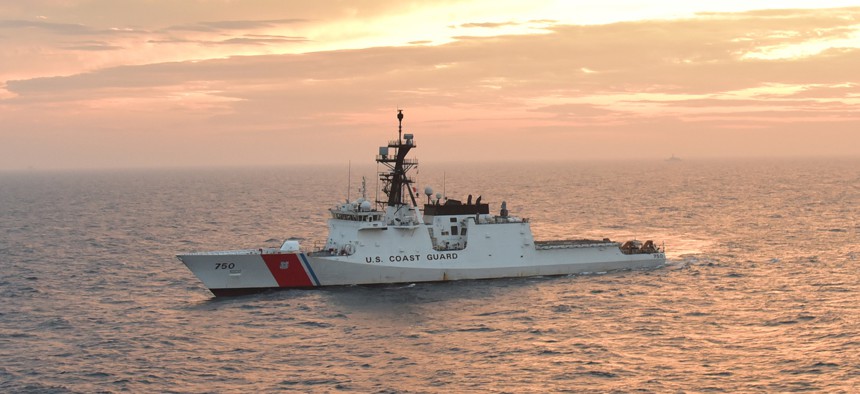
U.S. Coast Guard Cutter Bertholf (WMSL 750) basks in a sunset glow in the Yellow Sea during a 2019 deployment. U.S. Coast Guard / Chief Petty Officer John Masson
Coast Guard to Triple Western-Pacific Deployments, Policy Chief Says
The small maritime service is contending with data and connectivity challenges as it looks to expand its presence in the Pacific.
The Coast Guard, like its sister military services, is expanding its reach in the Indo-Pacific region. But it’s also working to make data more accessible across the service and boost connectivity for service members at sea.
“Can you imagine being on a 24-member crew sailing thousands of miles away on a 154-foot ship to share your experiences, your professionalism, with willing and emergent nations? A daunting task, but one that our crews love,” said Rear Adm. Michael Ryan, the Coast Guard’s deputy commandant for operations policy and capabilities, during the National Defense Industrial Association’s Expeditionary Warfare conference in Arlington, Va. on Wednesday.
Ryan’s office helps fulfill policy and tactical needs of crew members on missions that aren’t just limited to U.S. ports and waterways. Ryan said the maritime military service plans to triple its deployments to the western Pacific this year.
And in fiscal year 2024, the Coast Guard plans to deploy a 270-foot medium-endurance cutter with up to 100 crew members “to better compete with Chinese influence” and help allies and partners in the region. The service also expanded its small cutters with some based in Guam, frequently dispatched to Micronesia and “other Pacific Island countries to elevate maritime governance.”
Defense One caught up with Ryan, who was previously the commander of Coast Guard Cyber Command, after his presentation to talk more about his service’s priorities this year.
What is your office doing to increase the use of data analytics across the Coast Guard?
Our commandant understands that right now that's an opportunity for us. How do you leverage the insights that you've already collected? How do you take advantage of, you know, the historical context that she's already gathered? And so she's created a new office of data analytics and charged them with spearheading this effort across our entire organization.
What's currently in the way or missing, especially on the policy front?
You always start with the culture: do you have the environment where people understand that that's opportunity for them? And so Adm. Fagan is very driven to ensure that all of her leaders, and having that trickle down the organization, that they recognize this is important business for us. And so she's taken care of that. Message received, we're moving out.
And then I think the other piece is, what's the effective technology? [The data office] is on task to survey the marketplace to understand the portfolio of opportunities within the Coast Guard, whether it's in our law enforcement datasets, to our logistics chains, where we understand how do we better sustain our assets. [Brian Erickson, the Coast Guard’s chief data officer, who leads the office is] helping to cultivate an integrated data environment and also the analysis tools that we're going to plug into that environment that allow for those programs to take advantage of that opportunity that the commandant has created. So you know, it's culture, technology, and then just the drive to do it quicker.
Adm. Fagan mentioned increasing shipboard connectivity. How’s that going?
Principally, our chief information officer has that for tasking under our technology revolution, but the recipient of all that are the forces underneath my boss and the deputy commandant for operations. And they've done a great job in the last few years tripling the capacity of just sheer bandwidth onboard our largest assets, and then getting those same types of scale increases on all the rest of our hulls. And that's going to take you know, a little bit of time, but we're making substantial progress. You know, we've propagated that into our medium-endurance fleets over the last 12 months.
What milestones is your office working towards?
Well, hopefully most people are tracking some of the shipbuilding activities that we're doing. I mentioned our 11 National Security Cutters; that's a fairly sophisticated line. Sixty-five Fast Response Cutters, and I think we're at hull number 53, so we're nearing the end state of that acquisition, and we're figuring out ways to use those new platforms to maximum effect. The offshore patrol cutters will be game-changers, you know, we will splash the first of that class this year, and allow that to start on its operational journey. And then you have all the other maritime domain awareness, you know, technology, sensors, understanding; so those things are in motion and on the way.
What can we expect in the 2024 budget?
We're working through that. We always are mindful of the fact that these need to be reasonable investments, but they need to connect to something that's important to the nation. Now, you can look at our current assets, and it's always about readiness. How ready can you make those capabilities? How supportive will those resources be for your crews? That's always the starting part of this equation and the building block to take care of what you have. What does it take to operate that on a day-to-day basis? I know it's always getting more expensive. So you can expect that to encompass, you know, a good percentage—the predominant percentage—of whatever assets may come our way. You look at historical trends and we're in the $12 to 14 billion range. We need to continue to make those major capital asset investments to keep those lines hot. So that industry can deliver on those promises we need. And then you know, the marginal, where we can make new investments to allow you to get better for the adversaries of now and tomorrow. So those are things that you should see when the President elects to release his budget and hopefully gain support within our Congress.




